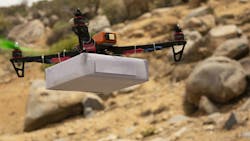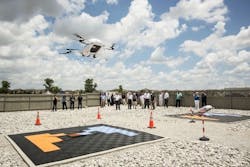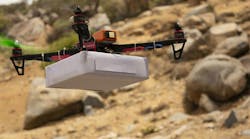Delivering Packages via Drone-as-a-Service
Drone-as-a-Service (DaaS)1 is what it sounds like. In this case, a company provides a drone to do a specific service, from creating a digital twin of a structure such as a house to providing package delivery. Drones may be autonomous, semi-autonomous, or under remote control depending on the application and service. The advantage to customers is the ability to have drone support without the required infrastructure and training needed to safely operate drones.
The Federal Aviation Administration (FAA) is working with the industry to make sure that drones take off and perform their duties, e.g., safe and quick package delivery right to homeowners and industry locations, but it brings up many challenges. Currently, most drones need to operate with line of sight (LOS) with respect to their pilots or controllers, and operation over or around people is limited. This tends to limit drone operation to about a mile.
The FAA is working to authorize drone flights well beyond this point. And NASA is joining forces with the industry and the FAA to implement an uncrewed traffic-management system for such operations.
Among DaaS’s features are:
- Rapid deployment: Drones can quickly deliver packages in hard-to-reach and urban areas.
- On-demand access: Company users can easily request drone services as necessary; as a bonus, it reduces capital expenditures.
- Real-time tracking enables owners to easily monitor deliveries in real-time, leading to enhanced customer satisfaction and transparency.
NASA Demonstrates DaaS
NASA’s Uncrewed Aircraft Systems Traffic Management Beyond Visual Line of Sight (UTM BVLOS) subproject is designed to support the growing demand for drone flights around the world (see figure).5,6
UAS, or drones, have increased the number of services available, beginning with package delivery and on to critical public safety operations, such as search and rescue missions.
NASA developed UTM so that drones could efficiently and safely be integrated into air traffic, which is already flying in low-altitude airspace. It’s based on digital sharing of each drone user’s well-planned flight details. This effort helps ensure that each user has the same situational awareness within the airspace.
NASA performed a series of drone flight demonstrations using UTM concepts in rural areas and densely populated cities under the agency’s previous UTM project. And commercial drone companies have since utilized NASA’s UTM concepts and delivery operations in limited areas.
>>Download the PDF of this article
Safety is a prime priority. On that front, NASA’s new drone, the MK30, has been given FAA approval to begin delivery operations to customers. The approval includes the ability to fly BVLOS, while using their sophisticated on-board detect and avoid system. This is a historic, first-of-its-kind commendation for a new drone system and a new operating location, which will follow a rigorous FAA evaluation of the safety of NASA’s systems and processes.
DaaS Applications
One application where DaaS may come into play is the creation of digital twins for structures like houses or bridges. These virtual models can provide useful information for testing, simulation, and analysis as, well as help with maintenance.
Having the drone scan an area and upload the information can be challenging for a casual user who performs this task only once or twice. The technology has been advancing with better LiDAR sensors, and high-resolution cameras such as thermal cameras that provide more details for the digital twin.
Dedicated imaging sensors allow users to collect key information about particular regions. Applications include agriculture, wildlife conservation, environmental monitoring, and most importantly, search and rescue operations. For example, drones may be used to monitor the surrounding effects of climate change in forests or identify pest infestations within crops.
Drones have the unique ability to function remotely, even when in quite dangerous areas. They’re able to avoid any of the dangers that might occur with human-piloted aircraft. Thus, they’re typically deployed for missions such as searching for survivors in disaster-affected areas or monitoring highly dangerous volcanoes.
The small size and electric propulsion of drones are obvious advantages over traditional aerial vehicles like airplanes and helicopters, too. Moreover, drones are lower cost for a variety of applications such as data collection and aerial photography.
DaaS and Emergencies
As mentioned, drones are useful tools in isolated and disaster-affected areas. Drones are able to move vital supplies quickly, even while venturing over difficult terrain, to save lives. However, maintaining drone support continuously may not be efficient if these problems are uncommon. DaaS would allow for their use on an as needed basis.
Delivery of medical supplies is one of the most significant uses of drones. These amazing air vehicles are trying to close the gap between people in need and the resources necessary, from medical equipment to blood lab samples. This is critically important during natural disasters or in areas with a poor healthcare infrastructure.
Consider an accident that occurs within a remote area. Traditional transit emergencies, poor road conditions, or a lack of good infrastructure may make them slow or even impossible to reach. Drones will be able to quickly transport life-saving supplies from any surrounding hospitals to remote areas.
Drones are also revolutionizing the field of diagnosis. Patients will be able to obtain suitable treatment plans and diagnoses much more quickly with the transportation of test samples. This become particularly crucial when there are time constraints.
DaaS and E-commerce
Retailers will relish DaaS for last-mile delivery, experiencing huge growth. This method is improving delivery efficiency and speed.
Gartner reported that the global last-mile delivery market size was valued at $40.5 billion in 2021 and is expected to generate $123.7 billion by 2030. Globally, e-commerce giants, such as Walmart and Amazon, have already been experimenting with the use of drones to access isolated and rural areas.
Drones have been applied to a wide range of businesses that serve different purposes, including agricultural (Ahirwar et al., 2019), law enforcement (Barrows, 2021), surveillance (Gohari et al., 2022), and emergency response (Wankmüller et al., 2021). Unfortunately, drones still are considered a challenging option to deliver products to consumers, especially during the last mile of the supply chain. So, scholars have been exploring drone last-mile delivery using multiple research lenses.
Consumer perceptions of last-mile delivery, intentions to adopt drones for such delivery, drone routing problems, and the impact of drone delivery on sustainability are the main research topics. Present research also considers investment in drones these last-mile deliveries and assesses the economic viability of such investments. It’s a vital question for the logistics industry because assessment is a prerequisite for any investment, especially when the latest innovative means should be explored.
Summary
Drones can be loaded with packages, while autonomously flying, or be remotely controlled to deliver items to homes or any other designated pickup locations. The FAA is monitoring drone delivery operations, which need participating companies to adhere to Part 135 certification for drone commercial flights. Now, Amazon is taking the next step in its Prime Air journey by beginning drone deliveries in the West Valley of the Phoenix Metro Area in Arizona.
So, customers living near the “Same-Day” site in Tolleson, Arizona, who may purchase an eligible item weighing five pounds or less, will have it delivered by drone in less than an hour.
References
1. A Comprehensive Guide To Drones As A Service (DaaS), Inside FPV.
2. SpeedyBee F7 V3 Stack includes an F722 flight controller and a 50A 128K ESC. Featuring BMP280 barometer, OSD, 500MB Memory Blackbox, a built-in FC LiPo monitoring system, and many more features, this stack is the perfect addition to your FPV build.
3. “Composing Drone-as-a-Service (DaaS) for Delivery,” Babar Shahzaad, Athman Bouguettaya, Sajib Mistry, and Azadeh Ghari, Neiat School of Computer Science, The University of Sydney, Australia, 2019 IEEE International Conference on Web Services (ICWS), IEEE Explore.
4. “Drone-as-a-Service for last-mile delivery: Evidence of economic viability,” ScienceDirect, Economics of Transportation, Volume 41, March 2025.
5. “Who Are The Big 3 In U.S. Drone Delivery?,” Harrison Wolf, contributing writer, Aerospace and Defense, January 28, 2024.
6. “NASA Moves Drone Package Delivery Industry Closer to Reality,” NASA, December 10, 2024.
7. “Learn More About NASA’s UTM BVLOS Subproject,” NASA, December 9, 2024.
>>Download the PDF of this article
About the Author

Steve Taranovich
Freelance Technical Writer, Phoenix Information Communication LLC
Steve is a contributing editor to Electronic Design.
Author of the non-fiction “Guardians of the Right Stuff,” a true story of the Apollo program as told by NASA and Grumman Corp. engineers, an astronaut, and technicians.
Experienced Editor-In-Chief of EETimes/Planet Analog and Senior Technical Editor at EDN running the Analog and Power Management Design Centers from 2012 to 2019.
A demonstrated history in electronic circuit design and applications for 40 years, and nine years of technical writing and editing in industry. Skilled in Analog Electronics, Space-related Electronics, Audio, RF & Communications, Power Management, Electrical Engineering, and Integrated Circuits (IC).
1972 to 1988 worked as a circuit design engineer in audio (8 years) and microwave (8 years). Then was Corporate Account Manager/applications engineer for Burr-Brown from 1988 to 2000 when TI purchased Burr-Brown. Worked for TI from 2000 to 2011.
Strong media and communication professional with a BEEE from NYU Engineering in 1972 and an MSEE from Polytechnic University in 1989. Senior Lifetime member of IEEE. Former IEEE Long Island, NY Director of Educational Activities. Eta Kappa Nu EE honor society member since 1970.


